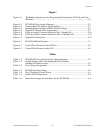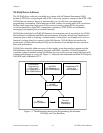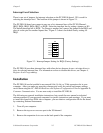Chapter 1 Introduction
© National Instruments Corporation 1-5 PC-DIO-24 User Manual
The CB-100 is useful for initial prototyping of an application or in situations where PC-DIO-96
interconnections are frequently changed. Once a final field wiring scheme has been developed,
however, you may want to develop your own cable. This section contains information for the
design of custom cables.
The PC-DIO-96 I/O connector is a 100-pin, Centronics-style, male, ribbon-cable header
connector. The manufacturer and the appropriate part number for this connector is as follows:
• Robinson Nugent (part number P50E-100P1-SR1-TG)
The mating connector for the PC-DIO-96 is a 100-position, polarized, Centronics-style, female,
ribbon-socket connector with strain relief. National Instruments uses a polarized (keyed)
connector to prevent inadvertent upside-down connection to the PC-DIO-96. This 100-pin
connector attaches to two 50-pin cables, each of which can be connected to a 50-pin connector
on the other end. The recommended manufacturer and the appropriate part number for the
100-pin mating connector is as follows:
• Robinson Nugent (part number P50E-100S-TG)
The recommended manufacturer part numbers for 50-pin, female, ribbon-socket connectors
suitable for use with the preceding connector are:
• Electronic Products Division/3M (part number 3425-7650)
• T&B/Ansley Corporation (part number 609-5041CE)
Recommended manufacturers and the appropriate part numbers for the standard ribbon cable
(50-conductor, 28 AWG, stranded) that can be used with both the 100-pin and the 50-pin
connectors are:
• Electronic Products Division/3M (part number 3365/50)
• T&B/Ansley Corporation (part number 171-50)
Unpacking
Your PC-DIO-96 board is shipped in an antistatic package to prevent electrostatic damage to the
board. Electrostatic discharge can damage several components on the board. To avoid such
damage in handling the board, take the following precautions:
• Ground yourself via a grounding strap or by holding a grounded object.
• Touch the antistatic package to a metal part of your computer chassis before removing the
board from the package.
• Remove the board from the package and inspect the board for loose components or any other
sign of damage. Notify National Instruments if the board appears damaged in any way. Do
not install a damaged board into your computer.
• Never touch the exposed pins of connectors.


















